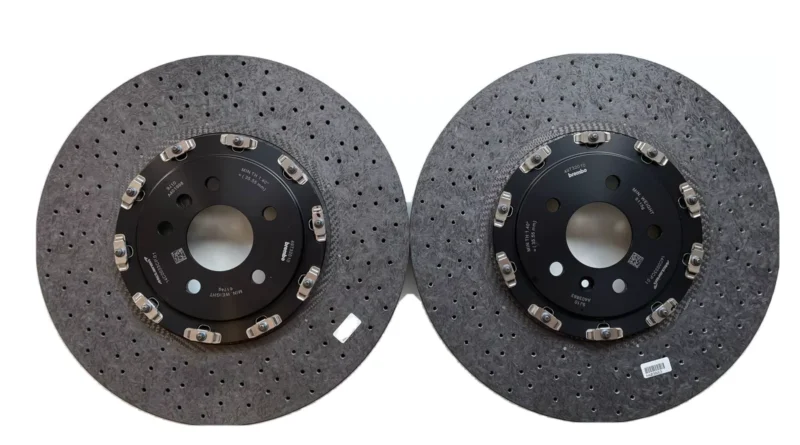Detailed Guide What Are Carbon Ceramic Brakes?
This article delves into what are carbon ceramic brakes are, how they work, their benefits, and why they are a popular choice among performance enthusiasts and automotive manufacturers. Carbon ceramic brakes are a high-performance braking system designed to offer superior stopping power, reduced weight, and increased durability compared to traditional steel or iron brakes. Used predominantly in high-end sports cars, luxury vehicles, and some high-performance motorcycles, carbon ceramic brakes represent a significant advancement in braking technology. Average cost around is expensive £20000 for all 4 set with ceramic pads. Lifespan 150,000miles or 10-15 years depends how vehicle is driven. Would not last if used for track days.
What Are Ceramic Brakes?
Ceramic brakes are composed of a carbon fiber-reinforced ceramic composite material. This material is created by combining carbon fibers with a ceramic matrix, resulting in a brake disc that is both incredibly strong and lightweight. Unlike traditional brake discs made from cast iron or steel, ceramic brake discs are designed to withstand extreme temperatures and provide consistent performance under demanding conditions.
How Do Ceramic Brakes Work?
The working principle of carbon ceramic brakes is similar to that of conventional brakes but with some key differences:
- Heat Dissipation: Ceramic brakes excel at dissipating heat. When the brake pedal is pressed, brake pads clamp down on the rotating brake disc, creating friction. This friction generates heat, which carbon ceramic materials can effectively dissipate, preventing the brakes from overheating and maintaining consistent performance.
- Friction Material: The brake pads used in carbon ceramic brakes are typically made from advanced materials that complement the ceramic composite of the brake discs. These pads are designed to operate efficiently at high temperatures, providing reliable stopping power.
- Durability: The carbon ceramic material is incredibly durable and resistant to wear. This means the brake discs have a longer lifespan compared to traditional metal discs, which can warp or crack under extreme conditions.
Benefits of Ceramic Brakes
1. Superior Performance
Ceramic brakes provide exceptional stopping power, especially at high speeds. This makes them ideal for performance vehicles that require reliable braking under extreme conditions.
2. Lightweight
One of the significant advantages of ceramic brakes is their reduced weight. They are significantly lighter than traditional metal brakes, which helps reduce the overall unsprung weight of the vehicle. This reduction in weight can improve handling, acceleration, and fuel efficiency.
3. Heat Resistance
Ceramic brakes can withstand much higher temperatures without losing performance. This makes them ideal for track use, where brakes can reach extremely high temperatures due to repeated hard braking.
4. Longevity
The durability of carbon ceramic brakes means they have a longer lifespan compared to traditional brake systems. They are less prone to wear and tear, which translates to less frequent replacements and lower long-term maintenance costs.
5. Reduced Brake Fade
Brake fade occurs when the braking system overheats, reducing its effectiveness. Carbon ceramic brakes are highly resistant to brake fade, ensuring consistent performance even under heavy use.
Why Choose Ceramic Brakes?
High-Performance Applications
Ceramic brakes are the preferred choice for high-performance vehicles, including supercars, hypercars, and luxury sports sedans. Manufacturers such as Ferrari, Porsche, Lamborghini, and McLaren equip their flagship models with carbon ceramic brakes to ensure optimal braking performance.
Luxury and Prestige
Beyond performance, carbon ceramic brakes also add a level of prestige and luxury to a vehicle. The presence of these advanced brakes is often a sign of a top-tier, high-performance automobile, appealing to enthusiasts who demand the best in automotive technology.
Cost Considerations
While ceramic brakes offer numerous benefits, they come at a higher cost than traditional brakes. The materials and manufacturing processes involved are more expensive, which is reflected in the price. However, for those seeking the ultimate in braking performance and longevity, the investment can be well worth it.
Maintenance and Care
Proper maintenance is essential to ensure the longevity and performance of carbon ceramic brakes. This includes regular inspections, proper bedding-in procedures for new brakes, and using the correct brake pads designed for ceramic discs.
Conclusion
Ceramic brakes represent a significant advancement in braking technology, offering superior performance, durability, and heat resistance. While they come at a higher cost, their benefits make them a popular choice for high-performance and luxury vehicles. By understanding how ceramic brakes work and their advantages, you can appreciate why they are considered the pinnacle of braking technology in the automotive world. Whether you’re a car enthusiast or simply looking for the best performance for your vehicle, carbon ceramic brakes are a remarkable option to consider.
Buying a used VW. Buying used vauxhall, BMW, Jaguar, Ford, Volvo, Range rover, Bentley, Aston Martin, Porsche, Ferrari, Lamborghini, Maserati, Hyundai, Tesla, Honda, Pagani

